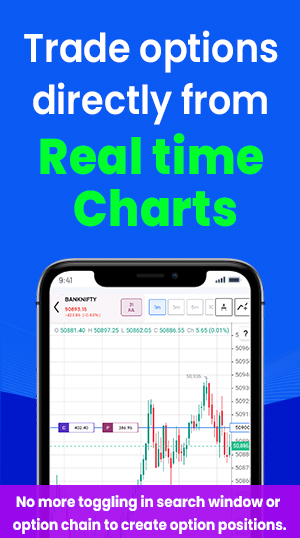In trading using the technical indicator is not only necessary to make your trade successful but also helps to maximize the chances of returns and minimize the risk of losses. However, to use this indicator you have to perform the technical analysis, you need knowledge, skills and extra time with effort with all the resources like market data and tools.
In intraday trading, you have limited time to perform the analysis and pick the right stock. Even some of the technical indicators are not applicable or useful while analysing the stock for day trading. However, there are still a few indicators that you can use for intraday. RSI is one of them we are going to talk about, how you can use it for intraday trading with the right strategy.
What is RSI Indicator in the Stock Market?
RSI stands for Relative Strength Index is a technical indicator used for trading to know if the stock is trading in the overbought or oversold zone. This indicator is based on the movement of price for a specific period and shows certain values between 0 to 100 indicating the level of market condition or an individual stock is trading in a low or high trading zone.
When the RSI indicator is moving above the 70 levels then it is considered the market or the stock is trading in the overbought zone. From this level, there is less chance of moving ahead and an even higher chance of turning back in a downward direction.
Also Read: What is RSI in Trading & How RSI Works? Formula and Strategy
On the other hand, when RSI is moving below 30, it means the market or stock is trading into the oversold zone. Due to downward movement or falling in the price, the RSI came into this overselling zone and is not likely to reverse back into the upwards direction.
What is RSI Indicator Used for?
The RSI of the relative strength index is used to know the current trend or strength of the price, where it is trading and whether is it the right zone to buy or sell the stock. Based on the RSI levels that you can see on the chart you can use the RSI to take the buying selling decision.
If RSI is hovering above the 70 level, it means the stock is overbought and has already shown upward movement, and now there is no room left for further upward movement. Here you can enter into short selling to take advantage of the stock available at lower levels.
Apart from this, the RSI indicator is also used for identifying the bullish and bearish divergence. When the RSI remains above 30 even during a pullback and repeatedly crosses 70, it shows the trend in the stock is strong. On the other hand, when the RSI stays below 70 and very often goes below the 30 levels, it indicates a downtrend in the stock or market.
Also see: How to Identify Trend in Stock Market: 10 Points to Find Trend
As per widely believed assumption, when RSI is trading below 30 or trading in the oversold zone, you can buy the underlying and sell with profits. When RSI is above 70 in the overbought zone, then it is a good opportunity to short-sell the stock keeping in mind underlying momentum and chart pattern. However, in both conditions trend reversal is possible, hence make sure or wait prior to downtrend or uptrend before entering into any trade position.
How to Use RSI Indicator for Day Trading?
Now coming to the point on how to use RSI indicator in intraday trading. RSI can be used to generate trade signals for short-term as well as for day trading strategies. But you have to choose or set the time period setting in RSI as per the intraday trading.
Also Read: How to Do Intraday Trading: Best Stocks, Charts & Strategies
For day trading you need to find the momentum in stocks and analyse the price movement and RSI on minutes or hourly based trading on the chart patterns. So, what should be the best setting for RSI that you should use for intraday trading?
RSI Indicator Setting for Intraday Trading
The default setting when you apply RSI indicator on any script is set for 14 periods, which means the last 14 trading sessions are used to calculate RSI value. However, based on your time horizon and trading strategy you can adjust the RSI for different time periods. And as per the traders the 14-day timeframe RSI is suitable for the swing trading.
Also Read: How to Add & Use RSI Indicator in TradingView: RSI Settings & Strategy
For intraday trading, you should use the timeframe of 8-11 periods, however, you can also increase or decrease the timeframe but for day trading the shortest time period will give you a better insight into the stock price movement for that period.
Though the RSI value remains between 0 to 100, you can set the buying and selling points at 30 and 70 levels. However, few traders consider the 20 and 80 as the oversold and overbought zones while using RSI in their technical analysis. In 30-70, you can consider the buying signal when the RSI is around 50, while in 20-80, the buying signal would be around 60 levels.
RSI Strategy for Intraday Trading
Intraday trader is quick trade on a shorter time frame and their trade usually last from few minutes to a trading session. Intraday traders buy the stock and sell before the market closes or vice-versa. Hence, you have to choose a low timeframe RSI indicator to get accurate results and take the right action.
Now after adjusting the RSI settings, you can use this indicator independently or in combination with other indicators. There are many useful RSI based trading strategies that you can use while taking trade during intraday trading, let find out how to trade.
Using the RSI Divergences
The RSI indicator can be also used for knowing the divergences as per the movement in the price of the underlying security. A divergence in RSI happens when the price of the underlying security or market index and RSI do not move in the same direction.
A bullish divergence can be identified if the price of the underlying security is slipping in a lower trend, while the RSI is edging towards the upwards direction. This could be a signal of a trend reversal, which means the price is in a downward trend, but a trend reversal to an upward direction is about to happen.
Also Read: What are the Best and most Accurate Trend Reversal Indicators
Similarly, a bearish divergence can happen when the price of the underlying security is edging towards the upwards direction but the RSI is moving to a downward direction. This divergence is the indication that upward movement in the stock is likely to reverse and a downward trend is likely to start. The divergences can happen as per the market conditions.
Moving Average Crossover (MACD)
For intraday trading strategy, you can also use the moving average convergence divergence (MACD). When RSI is moving ahead from an oversold zone, it gives a buy signal, while at the same time if MACD is leading to a bullish crossover. The indicator gives you an indication to enter into the long trade positions for intraday.
Also Read: How to Use Moving Averages in Trading & Convergence Divergence
Conversely, if the RSI is moving away from the oversold zone and at the same time the MACD is showing the bearish crossover, it means the trend is downwards. It provide you an indication that you can enter into the short-selling. Along with RSI, you can also use the MACD to determine whether the price trend is accelerating or decelerating.
Using the RSI in Trendlines
For intraday trading you can also use the RSI indicator in trendlines on the RSI chart and when trading is broken. For that, you have to connect the highest and lowest price levels on the trading chart. Now you have to draw the RSI uptrend by connecting three or more highs on the RSI line projecting the trendline in the future.
Also Read: How to Find Trending Stocks for Intraday Trading: Ten Rules
Similarly, when RSI is dropping, downward trendlines can be drawn by connecting two or more highs and then projecting the line into the future. However, if the price of the underlying security breaks above a downward trendline, it means the price is moving ahead in upward direction or the uptrend is likely to continue or there could be a trend reversal.
Using the RSI with Bollinger Bands
For intraday trading, you can also use the Bollinger Bands with RSI indicator to get buying and selling signal. Bollinger band is a indicator that reflects volatility. When the volatility spikes the bands expands and when the volatility contract, the bands contract.
Using Bollinger bands in conjunction with RSI, you can see the selling opportunity when the price is touching the lower Bollinger band. Similarly, when RSI goes below 30 and comes again above 30 levels it means there is a bullish signal, as the right opportunity to go long for intraday.
RSI with Candlestick Chart Patterns
Using the RSI with price data on candlestick chart patterns is one of the best ways to analyse the stock price movement for intraday trading. However, you can also use the line chart or bar chart but candlestick charts are more compressive and give better signals of buying or selling with a clear trend visible when you combine the multiple candlesticks in one row.
Also Read: How to Read, Analyse& Use Candlestick Chart Patterns for Trading
Here for intraday, if the RSI is below 30, the price is moving in the oversold zone and the candlestick chart is making the bullish formation with a double bottom in the downtrend. It is giving a buy signal for intraday with the possibility of upside movement in the next moves. For intraday trading, you can choose the hourly or minute timeframe using candlesticks charts.
Also Read: Which Candlestick Pattern is Most Reliable for Trend Reversal
Summing-up
Relative Strength Index (RSI) is the momentum oscillator indicator that shows the strength of the price trend and the current position of the stock. The values in the RSI are between 0 to 100, but 30 to 70 is the best range considered by most traders for making trade decisions. When RSI is above 70, it shows the stock price come into the overbought zone, giving a signal of short-selling, while an RSI below 30 means the price plunged into the oversold zone giving the buying opportunity.
Also Read: How to Decide Best Entry & Exit Points in Intraday Trading
RSI setting is by default set at a 14-day period; for intraday trading you can set the duration between 8 to 11 days. Using RSI in the intraday trading strategy also allows you to make use of trendline, MACD divergences, and candlestick chart patterns. Apart from these typical tools, though, there are several different technical indicators and tools available for intraday trading or day trading depending on the market.
You can choose Moneysukh to trade your trading strategies and is recommended by the market experts. You can trade option directly from chart no tension to jump to different window for placing orders. You can open your demat account and get access to an online trading platform to trade in intraday at the lowest brokerage charges.

















